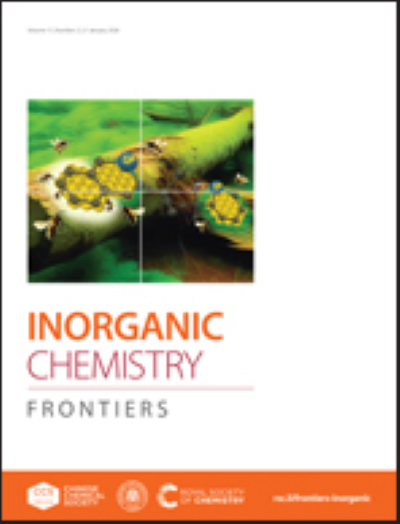环(烷基)(氨基)碳烯对 C=O 键的硅烷基化作用以及 CO2 扩增双(亚甲基)的自由基破碎作用
IF 6.1
1区 化学
Q1 CHEMISTRY, INORGANIC & NUCLEAR
引用次数: 0
摘要
将温室气体二氧化碳转化为增值产品是当代的一个重大挑战。由于金属中心的亲氧性,低价p-嵌段化合物通常在CO2的氧端反应。我们现在报道了一个n -杂环碳(NHC)稳定的对苯乙烯桥接双(germylene)在中心碳原子上选择性活化CO2和异氰酸乙酯。在净硅基化过程中,C=X (X = O, net)键通过低价金属中心和亲电性硅基主链的协同作用插入Ge-Si键中。多核磁共振数据、红外光谱和x射线分析证实了产物中保留了锗(II)中心,并得到了DFT计算的支持。单晶x射线衍射和连续波EPR光谱证明,用环(烷基)(氨基)碳烯(CAACs)取代NHCs的尝试通过Si-O键的均匀裂解产生了革烯- caac自由基。本文章由计算机程序翻译,如有差异,请以英文原文为准。
Silagermylenation of C=O bonds and radical fragmentation of CO2-expanded bis(germylene) by a cyclic (alkyl)(amino)carbene
The transformation of the greenhouse gas CO2 into value-added products represents a major contemporary challenge. Low-valent p-block compounds typically react at the oxygen termini of CO2 due to the oxophilicity of the metal centers. We now report on the selective activation of CO2 and ethyl isocyanate at the central carbon atom by an N-heterocyclic carbene (NHC)-stabilized para-silylenephenylene-bridged bis(germylene). During the net silagermylenation, the C=X (X = O, NEt) bonds are inserted into the Ge–Si bonds through cooperativity of the low-valent metal center and the electrophilic silyl backbone. The germanium(II) centers are retained in the products, as is confirmed by multinuclear NMR data, IR spectroscopy and X-ray analysis and supported by DFT calculations. Attempts to substitute the NHCs by cyclic (alkyl)(amino)carbenes (CAACs) resulted in a germylene-CAAC radical by homolytic cleavage of the Si–O bonds as evidenced by single crystal X-ray diffraction and continuous-wave EPR spectroscopy.
求助全文
通过发布文献求助,成功后即可免费获取论文全文。
去求助
来源期刊

Inorganic Chemistry Frontiers
CHEMISTRY, INORGANIC & NUCLEAR-
CiteScore
10.40
自引率
7.10%
发文量
587
审稿时长
1.2 months
期刊介绍:
The international, high quality journal for interdisciplinary research between inorganic chemistry and related subjects
 求助内容:
求助内容: 应助结果提醒方式:
应助结果提醒方式:


